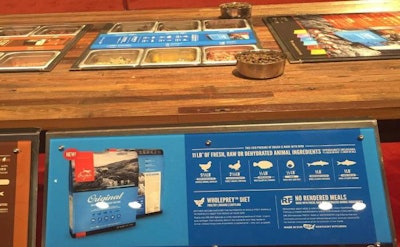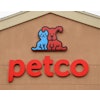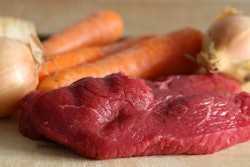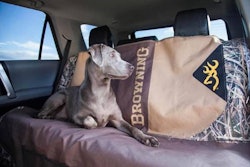
I attend Global Pet Expo every year with two clear goals: watch for pet food trends and talk to professionals from pet food companies and brands. The 2016 show did not disappoint in helping me achieve both objectives.
Since I previewed the specific trends I would be looking for, I will report on those. But first, I have to mention one that I didn’t anticipate: the rising tide of small meals for cats and dogs, especially in packaging relatively new (or at least not as prevalent to date) to the US market, such as small trays. With dogs, this is to some extent a continuation of the ongoing trend of catering to the growing population of smaller breeds. However, these new smaller meals in trays are also popping up everywhere for cats (see more below).
Now, on to the follow-up of my pet food watch preview:
Anything truly new, unique, innovative, ground-breaking? Well, no, but that doesn’t mean pet food companies have been standing pat with their product, marketing or distribution initiatives. Néstle Purina PetCare is expanding its Pro Plan Bright Mind brand to include adult dogs (pre-senior), with the aim of helping prevent any mental deterioration using the medium-chain triglycerides (MCTs) featured in the initial line for senior dogs. (Tip: These MCTs can help mental acuity in pet owners, too, according to Dr. Kurt Venator of Purina. Purina researchers even share a cookie recipe among themselves.)
Venator and Paul Cooke, VP/director of trade and industry development, also addressed Purina’s recent recall of some Beneful and Pro Plan products for “very slight underages” in a few minerals and vitamins. They stressed that no dogs were in danger from the situation, but because the levels “weren’t what they promised,” they pulled the products and have since refilled orders with products approved by the Food and Drug Administration as having the recommended levels.
Purina’s largest competitor, Mars Petcare, made news with its announcement that it is relaunching its California Natural and Evo brands to again be exclusive to the independent pet specialty channel, which Mars defines as no “big box” pet stores and no ecommerce, according to Brad Locke, marketing director. This was an interesting turn of events: the brands were originally developed by Natura Pet Products and marketed exclusively to independent pet retailers.
When Procter & Gamble acquired Natura in 2010, many retailers (and some consumers) bemoaned the move, remembering how P&G expanded distribution of the Iams and Eukanuba brands into mass market and other channels after acquiring the Iams Co. While the Natura brands were mainly sold in pet specialty after the P&G acquisition, that did include some Petco and PetSmart distribution, angering independent retailers. A series of recalls in 2013 did not help. So now Mars is taking the brands full circle back to their original distribution and trying to overcome some recent painful history with the independent pet channel.
Is last year’s emerging trend of “enhanced” kibble is spreading? Yes. Not only are companies like Wellness and Merrick Pet Care expanding the lines they launched last year (TruFood and Backcountry, respectively, with the latter now extending to cat food), but also Purina is launching a new cat food line under the Pro Plan brand, Shredded Blend, a kibble enhanced with “tender meaty shreds.” (It’s not clear how these pieces are processed.) There likely were other examples that I did not have the time to notice or document.
More freeze-dried, raw and baked pet foods and treats? A qualified yes. Definitely these so-called alternative formats are making their presence known in pet treats, where the smaller quantities help mitigate the often high costs of production, which typically have to be passed on to consumers. For complete and balanced pet foods, it’s a tougher sell.
I did see a couple of examples of new freeze-dried pet food: Merrick’s Backcountry line now includes small bags of just the freeze-dried pieces for dogs. And Bixbi, a small manufacturer based in Boulder, Colorado, USA, debuted Rawbble, a completely freeze-dried food for dogs with the tagline “Raw nutrition + kibble convenience.” What’s not convenient, at least for pet owners, is the retail price of these products: up to about US$60 for a 30-ounce bag. A Bixbi representative stressed that the Rawbble line is targeting small breeds, but I assume that will be only those owned by affluent consumers.
Would cats finally feel the love? Yes! Many pet industry members and watchers, including me, have lamented the lack of development of foods and other products for cats. Manufacturers must have heard the call—or, more likely, are aware of Millennials gravitating toward cats—because I saw new cat food lines aplenty, including some fairly interesting concepts. Besides the expansion of 2015’s new product launches—Backcountry, already mentioned, plus Open Farm and several others, into cat food—and other line extensions (Purina’s Muse, Wellness’ Trufoods Meal Complements, for cats and dogs), brand new cat food lines included Solid Gold’s Holistic Delights, similar to a bisque, with a coconut-milk base; and its Purrfect Pairings, a mousse with a goat-milk base.
Would dog treats finally overtake the Orlando Convention Center? Not quite, but there were even more new dog treats than in years past, which I didn’t think was possible. Note the trendy new ingredients: goat meat and hemp. Not in the same products, and while hemp isn’t new to pet treats, there seemed to be quite a few new ones featuring the ingredient.
How many “natural” pet food and treat claims? I didn’t even bother to count. Suffice it say that the Natural Products section of the show floor included many pet food and treat booths; and of course, natural claims were not limited to those booths.
Would transparency about ingredients, sourcing and processing be a key message? Yes. Open Farm further explained, graphically and verbally, just what the Certified Humane claim, the brand’s cornerstone, means, while also touting its new app that pet owners can use to trace, by lot code, the origin of all the ingredients in the Open Farm products they buy. In terms of ingredients, Solid Gold is now basing its marketing and promotions on the 20 superfoods used in its products. Petcurean is keying on its Canadian heritage, location and sourcing of nearly all the ingredients in its products. The list goes on, including Champion Petfoods’ (another Canadian company) new “Meatmath” concept (see below).
Would the booths of recently acquired pet food companies reflect their new owners? No, Merrick’s showed not a trace of Purina’s ownership or influence, while the same could essentially be said for Sojos and WellPet.
Most entertaining pet food-related booth or marketing? The things that made me laugh the most are either inappropriate for a family website or based on rather unfortunate errors. So instead, I’ll highlight an innovative display (see photo at the top of this page) by Champion for its Meatmath campaign: a bar of the actual, raw meats, fish, vegetables and other ingredients used in its food (kept on ice and, presumably, freshened throughout the day). The Meatmath concept includes clear graphics and text on all Champion products showing the amount of meat, how much of it is fresh, whole, etc., its source and how much of the food to feed depending on the pet’s body type and lifestyle. Too bad consumers couldn’t see the Meatmath display, too.
Finally, some pet food data to report: Packaged Facts projects US pet food sales to increase 3.3% this year to US$31.26 billion, up from US$30.27 billion in 2015, according to a presentation by David Sprinkle, publisher and research director. (His presentation was mostly about Millennial pet owners and their buying habits.) The American Pet Products Association (APPA), organizers of Global Pet Expo, also released its final sales data for 2015, which included a total of US$60.28 billion for the entire US pet industry and US$23.05 billion for pet food sales, up 3.5% from 2014. Neither Packaged Facts nor APPA has ever been able to explain the discrepancy between their data sets, but at least both show growth for pet food sales.


















